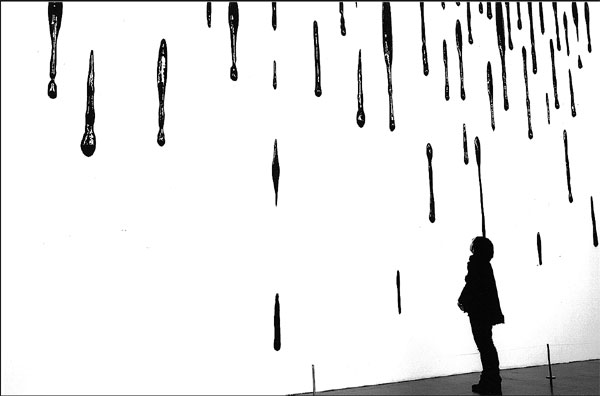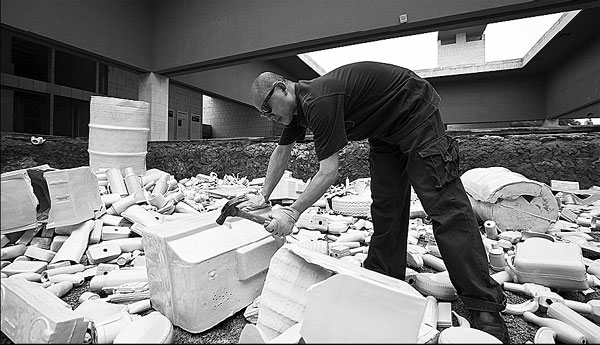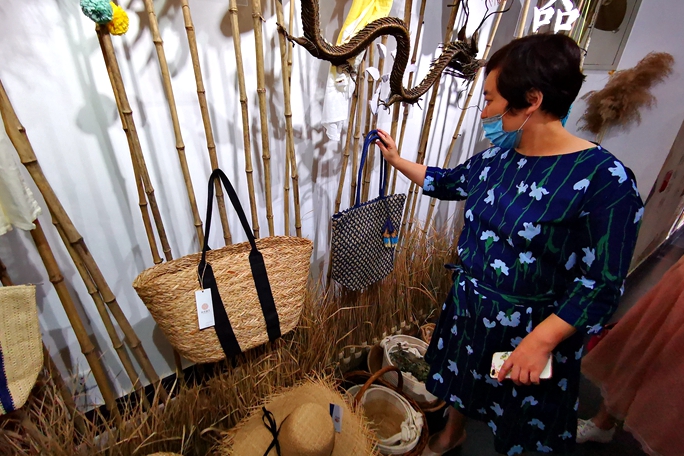Porcelain activist
Liu Jianhua is trying to break down the cliches associated with the delicate material to make it reflect social problems, Lin Qi reports.
After working with porcelain for many years, Liu Jianhua believes that the process of making an artwork is more important than what materials are used to create it.
In his installation series Trace, which is now on display at the Singapore Art Museum, Liu has put up black, ink drop-like porcelain pieces on a white wall, giving the impression of something dripping. The series won the 53-year-old professor of sculpture the Jurors' Choice Award of the Asia-Pacific Breweries Foundation Signature art prize in 2014.
Liu says he was inspired by wu lou hen (rain stains on the wall of a leaking house), an expression in Chinese calligraphy, where ink strokes are compared to shapes of water stains.
The artist, who teaches at Shanghai University, says that he changes the presentation of Trace according to different exhibition venues. At the Singapore Art Museum, for instance, he placed the porcelain drops on a wall near the spiral staircase that connects the first and second floors. As audiences climb up the stairs, more and more drops come into view.
"The 'ink drops' are like traces of the human mind and imprints of the human soul," Liu says. "When people enter this tranquil space, leaving behind the hustle and bustle of the real world, I hope the work will soothe their conflicted psyches."
At the age of 12, Liu left his native city of Ji'an in eastern China's Jiangxi province, for the town of the country's "pottery capital" Jingdezhan.
He apprenticed under his uncle, a technician at a local ceramic factory in the town, and received lessons in pottery for years.
Liu's gifts and diligence won him top prizes in Jingdezhen and at the national level too. Yet no matter how superb his skills were, Liu says, he then saw a bleak future for himself, imagining that he would most likely end up as a "replaceable screw on a production line", much like retired workers from his uncle's workshop.
But after reading Auguste Rodin: L'Art, by Paul Gsell, he was inspired to change tack: learn sculpture in college.
After about three years of preparations, Liu was enrolled in the sculpture department of Jingde-zhen Ceramic Institute in 1985. He thought he would never touch ceramic clay ever again.
After graduation, he landed a teaching job at an art college in Kunming in Southwest China's Yunnan province. Meanwhile with great vigor, he experimented in the contemporary art field.
His early works, mostly semi-abstract sculptures, expressed a certain amount of self awareness. He tried out various materials from mud to wood to colored fiberglass. In the Inharmonious series of 1994, he modeled a woman's body parts with fiberglass to mock consumerism on the rise in Chinese society.
But porcelain came into his life in a big way with the Memories of Infatuation series. His perspective of art had changed by then. He returned to Jingdezhen and found that no medium other than porcelain could give his work the texture and effect he desired, and created ceramic qipao (cheongsam dress) sculptures, human female forms without heads and upper limbs but only legs wearing high-heeled shoes.
Liu says that the tightness of the cheongsam is comparable to the repressed sexual curiosity of adolescence among Chinese who were born in his generation - the 1960s.
Through his qipao series, he seeks to show the contradictions between traditional culture and the modern world. The sophistication of ceramic texture, the shapes of cheongsam and the twisted legs are all meant to bring to the fore social issues triggered by consumerism, such as changes in the relationship between men and women.
"Porcelain looks hard, but it is actually fragile. So is life. Beautiful things in life will eventually be broken," he says.
Porcelain has recurred as the main material in Liu's many creations in the past few years. He has taken advantage of its many features to highlight the dilemma of urban development. Since 2008 he has been exploring the subject of "no meaning, no content" in this regard.
He detaches porcelain from the cliches associated with it to make the material speak to the social problems. Liu experiments with it to magnify personal emotions by enriching the form and presentation of porcelain.
"The more I work with porcelain, the more I discover its possibilities as the novelty medium of expression."
Contact the writer at linqi@chinadaily.com.cn
|
A visitor views artist Liu Jianhua's installation series Trace, which features porcelain drops on a wall. |
|
Liu works at his studio in Shanghai. Photos Provided To China Daily |

(China Daily 02/17/2015 page21)



 Shandong Culture and Tourism Consumption Season
Shandong Culture and Tourism Consumption Season Culture, tourism sectors pick up in Shandong as epidemic wanes
Culture, tourism sectors pick up in Shandong as epidemic wanes

